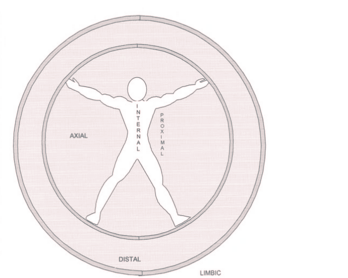 Image courtesy of Spitz and Fisher's Medicolegal Investigation of Death: Guidelines for the Application of Pathology to Crime Investigation, 4th Edition Image courtesy of Spitz and Fisher's Medicolegal Investigation of Death: Guidelines for the Application of Pathology to Crime Investigation, 4th Edition Trace Evidence Somatotactics: This describes trace evidence in relationship to the relative distance from the central core of the body. It’s a more subtle analysis of trace evidence and critical for medical legal investigators in using the body as the center of analysis, before gradually working out to the perimeter of the larger scene. If you think of the body like the drawing by Leonardo da Vinci’s man in a circle: The chest or trunk of the body is called the “internal” area. Moving a bit off the trunk is what is called the “proximal” and this describes all the evidence right next to the trunk area. Next are the areas within the reach of the arms and legs, which is the “axial” area. The area just out of reach of the arms and legs is called the “distal” area of the search pattern. Finally, the area out of ordinary sensory contact of the body is called the “limbic” area. Macroscopic: In the most general sense, macroscopic analysis involves the analysis of the bigger picture, or large units or elements. It is able to be seen by the naked eye. In medical legal death investigation, it means looking at the whole, or the larger aspect of what is being investigated and how things relate to each other. Microscopic: Microscopic analysis is looking at minute pieces of evidence many times through enhancements such as alternative light or magnification. It is not visible to the naked eye. In medical legal death investigation, it means analyzing invisible or indistinguishable trace evidence that can provide important information, ultimately playing into the overall macroscopic analysis of a scene.
1 Comment
|
Archives
September 2017
Categories |
